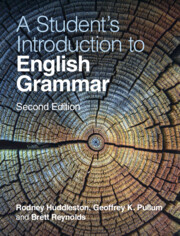Refine search
Actions for selected content:
6584 results in Grammar and Syntax
Chapter 5 - Meta-Theoretical Reflections
-
- Book:
- Universal Grammar and Iconicity
- Published online:
- 03 February 2022
- Print publication:
- 03 February 2022, pp 264-277
-
- Chapter
- Export citation
Chapter 3 - The Connectors
-
- Book:
- Universal Grammar and Iconicity
- Published online:
- 03 February 2022
- Print publication:
- 03 February 2022, pp 101-184
-
- Chapter
- Export citation
Acknowledgments
-
- Book:
- Universal Grammar and Iconicity
- Published online:
- 03 February 2022
- Print publication:
- 03 February 2022, pp xiii-xiii
-
- Chapter
- Export citation
Chapter 2 - The Serial Verb Constructions
-
- Book:
- Universal Grammar and Iconicity
- Published online:
- 03 February 2022
- Print publication:
- 03 February 2022, pp 17-100
-
- Chapter
- Export citation
Abbreviations
-
- Book:
- Universal Grammar and Iconicity
- Published online:
- 03 February 2022
- Print publication:
- 03 February 2022, pp xiv-xviii
-
- Chapter
- Export citation
Chapter 4 - From the External Argument Onward
-
- Book:
- Universal Grammar and Iconicity
- Published online:
- 03 February 2022
- Print publication:
- 03 February 2022, pp 185-263
-
- Chapter
- Export citation
Dedication
-
- Book:
- Universal Grammar and Iconicity
- Published online:
- 03 February 2022
- Print publication:
- 03 February 2022, pp v-vi
-
- Chapter
- Export citation
Figures
-
- Book:
- Universal Grammar and Iconicity
- Published online:
- 03 February 2022
- Print publication:
- 03 February 2022, pp x-x
-
- Chapter
- Export citation
References
-
- Book:
- Universal Grammar and Iconicity
- Published online:
- 03 February 2022
- Print publication:
- 03 February 2022, pp 289-304
-
- Chapter
- Export citation
Notes
-
- Book:
- Universal Grammar and Iconicity
- Published online:
- 03 February 2022
- Print publication:
- 03 February 2022, pp 278-288
-
- Chapter
- Export citation

A Student's Introduction to English Grammar
-
- Published online:
- 20 January 2022
- Print publication:
- 25 November 2021
-
- Textbook
- Export citation
Acknowledgements
-
- Book:
- Explanations in Sociosyntactic Variation
- Published online:
- 06 January 2022
- Print publication:
- 20 January 2022, pp xv-xvi
-
- Chapter
- Export citation
1 - Comparing Syntactic Variables
-
-
- Book:
- Explanations in Sociosyntactic Variation
- Published online:
- 06 January 2022
- Print publication:
- 20 January 2022, pp 30-57
-
- Chapter
- Export citation
Copyright page
-
- Book:
- Explanations in Sociosyntactic Variation
- Published online:
- 06 January 2022
- Print publication:
- 20 January 2022, pp iv-iv
-
- Chapter
- Export citation
Contributors
-
- Book:
- Explanations in Sociosyntactic Variation
- Published online:
- 06 January 2022
- Print publication:
- 20 January 2022, pp x-xii
-
- Chapter
- Export citation
Introduction: Analysing and Explaining Syntactic Variation
-
-
- Book:
- Explanations in Sociosyntactic Variation
- Published online:
- 06 January 2022
- Print publication:
- 20 January 2022, pp 1-29
-
- Chapter
- Export citation
Tables
-
- Book:
- Explanations in Sociosyntactic Variation
- Published online:
- 06 January 2022
- Print publication:
- 20 January 2022, pp viii-ix
-
- Chapter
- Export citation
Figures
-
- Book:
- Explanations in Sociosyntactic Variation
- Published online:
- 06 January 2022
- Print publication:
- 20 January 2022, pp vi-vii
-
- Chapter
- Export citation
2 - Mapping Syntax and the Sociolinguistic Monitor
-
-
- Book:
- Explanations in Sociosyntactic Variation
- Published online:
- 06 January 2022
- Print publication:
- 20 January 2022, pp 58-89
-
- Chapter
- Export citation
Index
-
- Book:
- Explanations in Sociosyntactic Variation
- Published online:
- 06 January 2022
- Print publication:
- 20 January 2022, pp 207-210
-
- Chapter
- Export citation
